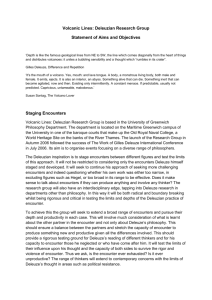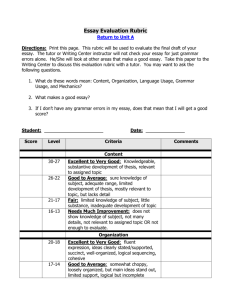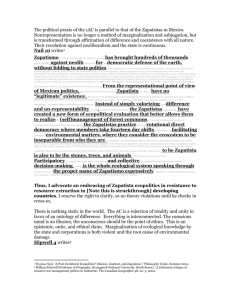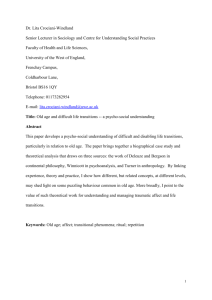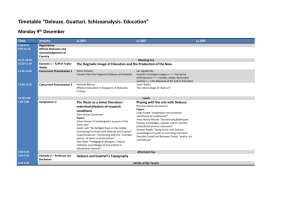Coffey, J (2013). Bodies, body work and gender: Exploring a
advertisement
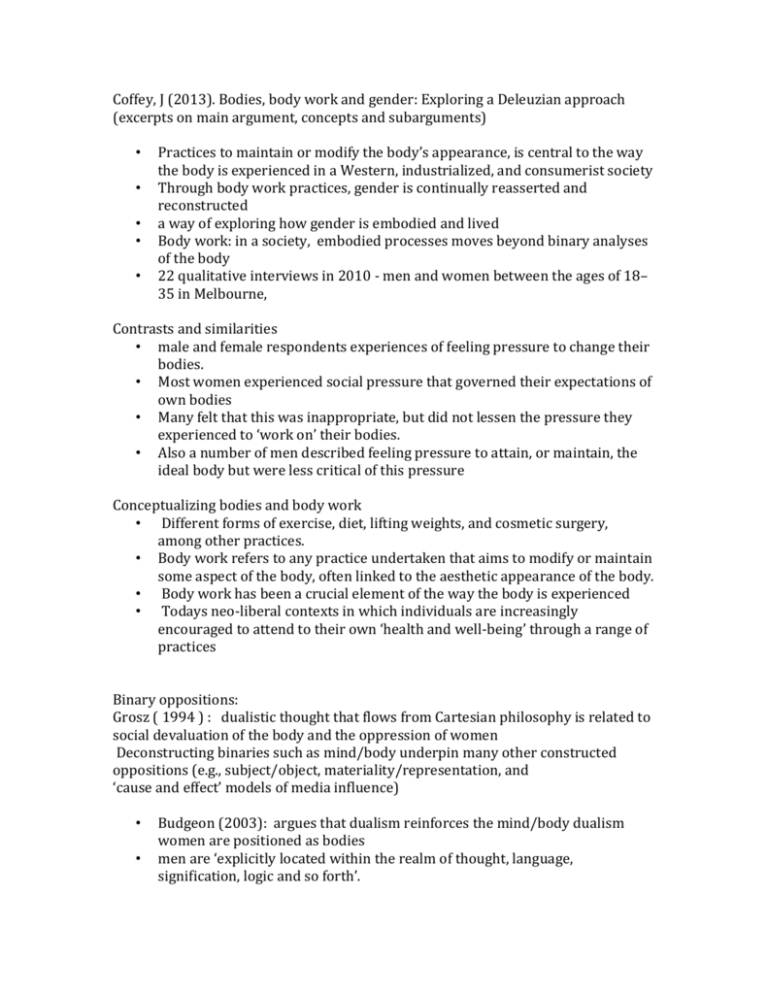
Coffey, J (2013). Bodies, body work and gender: Exploring a Deleuzian approach (excerpts on main argument, concepts and subarguments) • • • • • Practices to maintain or modify the body’s appearance, is central to the way the body is experienced in a Western, industrialized, and consumerist society Through body work practices, gender is continually reasserted and reconstructed a way of exploring how gender is embodied and lived Body work: in a society, embodied processes moves beyond binary analyses of the body 22 qualitative interviews in 2010 - men and women between the ages of 18– 35 in Melbourne, Contrasts and similarities • male and female respondents experiences of feeling pressure to change their bodies. • Most women experienced social pressure that governed their expectations of own bodies • Many felt that this was inappropriate, but did not lessen the pressure they experienced to ‘work on’ their bodies. • Also a number of men described feeling pressure to attain, or maintain, the ideal body but were less critical of this pressure Conceptualizing bodies and body work • Different forms of exercise, diet, lifting weights, and cosmetic surgery, among other practices. • Body work refers to any practice undertaken that aims to modify or maintain some aspect of the body, often linked to the aesthetic appearance of the body. • Body work has been a crucial element of the way the body is experienced • Todays neo-liberal contexts in which individuals are increasingly encouraged to attend to their own ‘health and well-being’ through a range of practices Binary oppositions: Grosz ( 1994 ) : dualistic thought that flows from Cartesian philosophy is related to social devaluation of the body and the oppression of women Deconstructing binaries such as mind/body underpin many other constructed oppositions (e.g., subject/object, materiality/representation, and ‘cause and effect’ models of media influence) • • Budgeon (2003): argues that dualism reinforces the mind/body dualism women are positioned as bodies men are ‘explicitly located within the realm of thought, language, signification, logic and so forth’. • • young women’s bodies particularly, media images are blamed for the ‘negative’ body images promoting or ‘representing’ young women in a sexualized way, or encouraging young women to emulate these representations Concepts of Deleuze and Guattari (1987) enable the body to be rethought as a process of connections, rather than an ‘object’ caught in dualisms. The body as an ‘event’ of becoming Deleuzian philosophies of becoming understand bodies not as objects upon which culture writes meanings, but in terms of what a body can do: the capacities, capabilities, and transformations that may be possible Spinoza’s conceptualizations of the ways bodies interact and connect with the world, Deleuze: The important thing is to understand life, each living individual it is a matter of how to live: it is by speeds and slownesses that one slips in among things, that one connects with something else. One never commences, one never has a tabula rasa The term ‘the becoming of bodies’ refers to the conviction that ‘bodies must be conceived of as processes continually moving, rather than as discrete, autonomous elements’. Deleuze’s idea of becoming : no duality of subject and object, materiality and representation, and questions of cause and effect relating to the body in the social world, because : Deleuze conceives of bodies not as discrete, independent entities but, rather, as constituted through their relations with other bodies and things. The term ‘becoming’ can be used as a way of understanding how bodies are experienced, affected, affecting, and ultimately lived. This conception of bodies is particularly relevant to practices and experiences of body work, A Deleuzian analysis of bodies and body work understands bodies as events – they are events as they are ‘continually in the process of becoming – as multiplicities that are never just found but made and remade’. They are not subjects and objects Because the focus is on the connections bodies make and the reconfigurations that result, seeing the body as an event is to acknowledge the multiple negotiations it undertakes Conceptualizing bodies as events privileges a position wherein bodies are involved in continuous connections with other bodies, rather than there being one causal point of origin as defining a body in terms of what it is and what it can do The practices of body work and social factors such as dominant ideals of gender can be seen as key mediating forces: connections which ‘work to form the event of the body’ Individuals connect with these forces through their body work practices and can be understood to become through these connections. Although social, political, and historical forces are crucial to analyses of body work and body practices, the outcomes of these forces, or what bodies can do in these contexts, cannot be known in advance. The body is productive because it connects (Deleuze and Guattari 1987); and a focus on these connections in analysis bridges the gap between gender as a concept and as an embodied experience. • • • Affect is: (Deleuze and Guattari (1987) as ‘the capacity to affect and to be affected’. Affects can also be understood as embodied sensations gender is ‘not something that pre-exists bodies, but constitutes bodies . . . Gender is one of the ways in which the affective capacities of bodies become organized and produced’ Analyzing bodies in terms of their relations, connections, and affects. Analyzing the specific practices and relations that form bodies … what bodies can do and how they connect, affect, and are affected in the context of broader social relations. Exploring becoming through ‘ideal’ gendered bodies • The body work practices of participants were largely shaped around what can be termed ‘hegemonic gender ideals’ • The meanings and experiences related to these gendered physicalities, however, were described in very complex ways. • Most participants explained that ‘ideal’ male bodies are muscular and would require body work practices of lifting weights; and ‘ideal’ female bodies are ‘skinny’ or slender and would require body work practices of dietary control and exercise • The gendered physicalities of these ‘ideal’ bodies relate to a range of underlying assumptions and inequalities around men’s ‘natural’ physical strength and prowess and women’s ‘natural daintiness’ • Although many participants did not endorse these ‘ideal’ figures, or do the sorts of body work required to ‘achieve’ these bodies, all identified them as the mainstream or popular ideal Concern for the body’s appearance was commonly understood by participants as a ‘feminine preoccupation’ Body work practices can be understood not as the effects of gender. Instead, gender can be understood as a relation bodies connect and engage with. Men and women in the study, describe their experiences of their bodies related to gender in complex, paradoxical, and ambiguous ways Concern for the body’s appearance was commonly understood by participants as a ‘feminine preoccupation’ Body work practices can be understood not as the effects of gender. Instead, gender can be understood as a relation bodies connect and engage with. Men and women in the study, describe their experiences of their bodies related to gender in complex, paradoxical, and ambiguous ways Kate’s and Angela’s bodies: understood as constituted through numerous relations, particularly with media images of women whose bodies are ideal because they are able ‘fit into any’ fashionable clothes, aligned with the consumer culture, beauty, and fashion industries. Kate and Angela also connect femininity with the bodies of ‘real women’ located outside of the ‘global fashion beauty complex’. This system is powerful and connected to binary gender which can help to explain why it is so ‘hard to accept anything other than’ slender femininity as ideal. Jason’s body can be understood as constituted, but not determined by, his relations with ideal gendered bodies. Jason used the same phrase as Kate in describing how seeing male footballers’ bodies communicates how he ‘needs’ and wants his own body to look. Men too are ‘increasingly drawn into the consumer culture body image game and are becoming more critical and vulnerable about their bodies’. The (young) female body continues to be particularly visible in the context of consumer culture through ‘spectacular femininity’, and greater scrutiny is given to women’s bodies The relations between Adam’s and Jason’s bodies and ideal masculinity can be read as examples of the ‘discipline and normalization’ practices that are usually used to refer to practices associated with the female body . Masculine identities are not constant and, through a Deleuzian focus on bodies, can be understood as unstable and in continual change and becoming. Jason and Adam do not problematize the dominant ideal of masculinity like Kate and Angela do in their discussions of ideal feminine bodies in which they ‘get caught up ’. The framework of becoming understands bodies as in continual, immanent processes of change and becoming, even when they repeat dominant conditions (including normatively gendered embodiments), rather than creating ‘lines of flight’ or newness. Becomings are ‘not necessarily exciting but often involve the recreation of the mundane, the ordinary, the same’ Exploring becoming is not a matter of examining what someone or something has become (for example, understanding Jason as becoming an idealized physical male subject through his body work). Instead, Jason’s becoming through body work needs to be understood as the process of engagement between his body and numerous other forces, namely the hegemonic masculine bodies he wants to emulate, also related to dominant discourses of masculinity related to athletic prowess, strength, and heterosexuality To explore bodies as becomings, rather than subjects or objects, the focus shifts towards the complexities and possibilities involved in relations between bodies and gender, rather than following established paths of knowledge regarding women, bodies, and images. A Deleuzian approach to bodies and gender involves exploring how knowledges, understandings, and experiences of bodies are produced through and become through gender and other relations, instead of analyzing bodies as the effects of gender relations Kate and Angela cannot be understood through a framework of becoming as ‘escaping’ normative gender relations through their critique; rather their relations with gender mean their bodies become in ways that are different to Adam and Jason. To explore bodies as becomings, rather than subjects or objects, the focus shifts towards the complexities and possibilities involved in relations between bodies and gender, rather than following established paths of knowledge regarding women, bodies, and images. A Deleuzian approach to bodies and gender involves exploring how knowledges, understandings, and experiences of bodies are produced through and become through gender and other relations, instead of analyzing bodies as the effects of gender relations Kate and Angela cannot be understood through a framework of becoming as ‘escaping’ normative gender relations through their critique; rather their relations with gender mean their bodies become in ways that are different to Adam and Jason. Deleuze and Guattari and Spinoza may provide one such way of moving beyond the problematic implications of dualistic thought. Their concepts enable us to focus on what bodies may be capable of rather than what bodies are , and what bodies may become rather than only the ways that certain bodies are constrained by ‘structures’ such as gender. The repetition of gender structures in some participants’ understandings and experiences of their own bodies and body work practices is not understood as reproducing these structures; rather gender here is understood as ‘produced through but not determined by its relations ’





